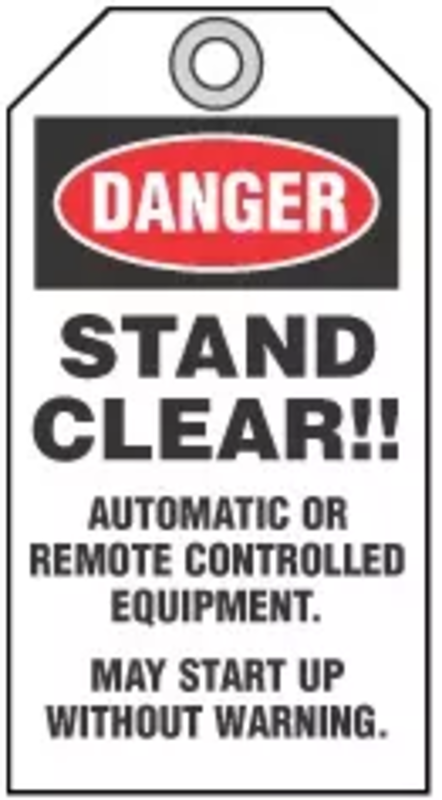Preventing potential danger with Operational hazard tags

Among the most frequently cited standards by OSHA in 2013 include those involving Lockout:Tagout, Construction, Hazard Communication (including Right-to-Know,) Confined Space, Electrical Components and Equipment.Interesting enough, there are accidental prevention tags that contain verbiage and symbols to help reduce accidents for all of these categories and more. If only they were to be used properly, if at all.Accident Prevention tags can be used to specify rules; to specify procedures; to announce Danger or Caution situations; to announce hazardous conditions; to provide “Right-to-Know” information; to record important data, to name just a few.
To begin, a safety tag a safety tag has to be able to stand up to the harsh outdoor and indoor environments and has to meet the requirements of OSHA 1910.145, “Specifications for Signs and Tags.”Idesco Safety Tags are constructed of 25 mil extra-tough plastic with the printing encapsulated inside the plastic. The tags have a hard-matte surface, which allow for writing and rewriting on the surface. The tags come with a 3/8 metal grommet and can “pull” well over 50 pounds when called for. This is the case for Lockout::Tagout situations (CFR1910.147.)With Lockout:Tagout, when equipment is being serviced, the mechanic(s) working on the equipment must insure that the equipment is both “Locked Out” and “Tagged Out.” The tag must include the OSHA “DANGER” symbol as well as the words “DO NOT OPERATE.” In addition the tag MUST be able to “pull” at least 50 pounds so that it will not separate from the padlock.
RIGHT-TO-KNOW regulations follows the principal that all employees have the “right to know” the types of chemicals to which they may be exposed in their workplace on an everyday basis. RIGHT-TO-KNOW tags include sections to indicate the level of Danger involved (from 1 to 4) for Health Hazard, Flammability and Reactivity. Safety Tags are ideal for announcing Operational Hazards. Many tags are available with symbols that clearly indicate the hazard involved. For example there are pinch-point, eye protection hearing protection, face protection and heat protection symbols that clearly and instantaneously display the appropriate message. In these cases, a picture is worth a thousand words.
Confined Space conditions can be deadly. Thus, OSHA requires a highly organized management of a confined space site. The Entry Supervisor controls who and when someone enters a confined space, through a sophisticated and comprehensive permit system. There are assigned safety tags for every person who will have authorization to enter a confined space. There are tags for the Entry Supervisor, the Entrant, the Test Technician, Rescue Service and any assigned contractor. Using the safety tags helps insure tight control in these very dangerous areas.
There is nothing more dangerous in an industrial setting than working in an area with electrical systems. The importance of placing DANGER, HIGH VOLTAGE tags on required equipment cannot be overstated. Other electrical equipment requiring proper tagging includes controls and switches.Preventing fires when dealing with flammable material is ongoing and never-ending. Safety tags are placed on or very near machinery and materials and indicate the types of flammable liquids – gasoline for one, or gases – such as oxygen. The types of actions that should be taken with these– such as no smoking.
Those working in the construction field are faced with a wide variety of materials, that when not addressed properly can lead to serious injury. There are safety tags to warn of dangers to the ears, eyes, hands. There are tags indicating the presence of biohazards, laser beams, and asbestos materials. If it is dangerous and an employee can come in contact with it, there has to be a tag to warn them of it Safety tags are also useful for keeping logs such as in Lubrication, Safety equipment and maintenance orders. The cumulative result in using safety tags is less accidents and a more productive workplace.